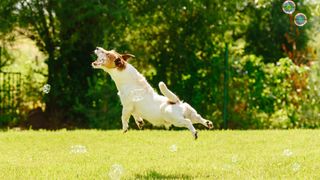32 ways to build more fun into your dog’s routine
Things getting a bit boring? Here's how to build more fun into your dog's routine

Finding ways to build more fun into your dog’s routine is not just about providing entertainment; it is a fundamental aspect of fostering a happy, healthy, and well-adjusted canine companion. Dogs, much like humans, benefit from mental stimulation, physical activity, and social engagement. Incorporating enjoyable activities into their daily lives not only prevents boredom but also helps address behavioral issues that can arise when dogs lack proper outlets for their energy and curiosity. A routine enriched with playful interactions and varied stimuli contributes to a more content and emotionally balanced pet – as well as providing an opportunity for exercise.
Plus, having fun together strengthens the bond between you. Dogs thrive on positive interactions with their owners, and shared moments of joy and excitement create a deeper connection. Knowing how to play with a dog fosters trust, communication, and a sense of security for them, reinforcing the notion that you are a source of comfort and enjoyment (as well as dinner).
It works both ways: happy times with your dog will boost your enjoyment of having him in your life. Play like children together, and make some memories.
Let’s take a look at some of the ways we can ramp up the fun factor with our dogs.
32 ways to build more fun into your dog’s routine
1. Variations to the game of fetch

There are myriad ways you can vary the simple game of fetch to challenge and excite your dog. As well as varying the object – think texture, size, aerodynamics – you can play in different places. Try fetch into water or on a hillside. Night-time fetch provides a further challenge – you can use a glow-in-the-dark ball, one with an LED, or just make the dog use his nose.
2. Hide and seek

You can either hide treats around the house for your dog to sniff out, or you can play in person. Make your dog sit and stay while you hide. You may need to enlist another person to help while he learns how to play. Call him enthusiastically and when he finds you, reward and praise him. You can develop your training commands (“stay”, “find me”) and increase the difficulty factor by hiding in more obscure places.
3. Agility courses in your back yard

Set up a mini obstacle course in your backyard and guide your dog through it. He may pick it up so well that he will be able to do it solo.
Use any household items to make it fun, from chairs to jump over, upturned plastic cups to bend in and out of, and a clothes-drying rack with a towel draped over for a makeshift tunnel.
4. Doggy playdates

Organizing doggy playdates involves coordinating with other dog owners, selecting a safe and neutral location, and ensuring that all dogs are well-behaved (and up-to-date on vaccinations).
Reach out first to friends and neighbors, as well as local dog groups to find potential playmates. Start with just one other dog, so it’s not overwhelming and you can gradually meet other dogs week by week in a controlled fashion. Pick a secure and neutral environment, such as a fenced backyard or a dog park, to minimize territorial behavior.
During the playdate, closely monitor the dogs’ interactions. If all goes well, a playdate should foster positive socialization, exercise, and enjoyment for both human and canine participants – and hopefully some new walking partners.
5. Teach new tricks

This requires a bit of patience but is hugely rewarding for both you and your pup. From simple commands like “lie down” to “paw”, you can teach dogs to roll over, play dead, jump through hoops or spin. Use positive reinforcement and plenty of praise and only the best dog treats, and they’ll pick it up in no time.
6. Water fun

Many dogs are naturally great swimmers. If your dog is comfortable in water, take them for a dip in a safe and calm water body. Always start in a shallow paddling area, and support and encourage them as they test it out.
Swimming is an excellent low-impact exercise that provides a full-body workout for your dog while allowing them to cool off. However, bear in mind that some breeds, like the French Bulldog, are not conformationally built for swimming and are best staying on dry land or – if they enjoy it – just going up to their knees in a controlled fashion.
You can also play fetch in water, many of the strong swimmers like Springer and Cocker Spaniels, and German Shorthaired Pointers, love to retrieve toys from the water.
7. Dog-friendly hiking

If your dog is fit and already used to long walks, take it a step further by heading off for a hiking adventure. It is a wonderful way to enjoy the great outdoors together.
Don’t neglect a backpack, with essentials such as water, a collapsible bowl, treats, a leash, waste bags, and any necessary permits for the trail. Always check before leaving home that the trail both permits dogs (many don’t) and that it is dog-friendly. Although dogs are remarkably agile, you don’t want to take them climbing up a rockface, or walking too close to the edge of cliffs.
Be mindful of their paws on rough terrain, and check for ticks after the hike.
8. Bubble chasing

Many dogs thoroughly enjoy chasing bubbles, finding the floating, translucent spheres intriguing and entertaining. The unpredictable movements and delicate nature of bubbles captivate them, tapping into their natural instincts to chase and catch moving objects.
This mix of playtime with their chasing instinct is an effective channel for both mental and physical stimulation – in a delightful, whimsical way.
You can get bubble mixes which are safe for dogs in pet stores.
9. Dog sports

Dogs naturally love to work and many are fabulously athletic. If you have a sporty dog, try out a few sports to see whether there is one that suits him to a T.
Possible sports in include agility, where they navigate a timed obstacle course; flyball, a relay race involving balls and hurdles; canicross – running with your dog in harness; and even “canine freestyle”, involving a choreographed dance routine with spins, moves and tricks which highlights the bond between handler and their dog.
10. Picnic together

Taking your dog with you for a picnic is a delightfully bucolic experience. As well as your own sandwiches, apple and crisps, pack a few of your dog’s favorite treats as well as a water bowl, and poop bags (appreciating this takes the gloss of the idyllic picture).
Bring a blanket, pick a beautiful spot, and enjoy the experience together. Your dog will love sharing in your moment in the great outdoors.
11. Road trips

So many dogs hover round the car when they know you are heading out and if you start packing bags into the trunk, those doggy eyes sure know how to make you feel guilty at the prospect of leaving them behind. So, take them with you! Dogs tend to be happy as long as they are with you, provided they are adequately fed and watered, and they will certainly be grateful not to be left out of a fun adventure.
If you’re staying with friends and family, check ahead they are happy for the pooch to join in. For camping and other overnight stops, many places will accept dogs but don’t leave it until your arrival to find out they’re not welcome.
12. Dog-friendly cafes

Many cafes and pubs welcome well-behaved dogs, and are becoming increasingly popular in many places. These are a boon for dog owners to enjoy a meal, a cup of coffee, or a snack without having to leave their pets behind.
Dog-friendly cafes often provide amenities such as water bowls, dog treats, and sometimes even special dog-friendly menu items.
13. Puzzle toys

Dogs find puzzle toys fun because they tap into their natural instincts and provide mental stimulation. These toys often incorporate elements of problem-solving and reward, engaging a dog’s cognitive abilities.
As dogs interact with the puzzle, they must figure out how to access treats or food hidden within compartments, encouraging them to use their noses, paws, and teeth. This type of mental engagement not only satisfies a dog’s curiosity but also helps prevent boredom and destructive behavior.
The challenge and reward aspect of dog-feeding puzzle toys mimics hunting and foraging behaviors, making the experience enjoyable and fulfilling.
14. Tug-of-war

Playing tug of war with your dog is great fun, as well as strengthening the bond between you.
It satisfies a dog’s natural instinct to pull and tug, providing both mental and physical stimulation. It’s also a great outlet for your dog's energy, promoting a healthy form of exercise.
Furthermore, the game fosters trust and cooperation, as your dog learns to follow your cues and release the toy when asked, so you can use it as a channel for reinforcing obedience and command training while having fun together.
15. Training classes

Training might sound intense and rules-based, but it can also be great fun for your dog. Training classes provide mental stimulation and enrichment by introducing new commands and challenges involving positive reinforcement with rewards and praise. Seeing and responding to other dogs can be enjoyable, or can help set your dog on the right footing if he is anxious.
From the handler’s point of view, the structured environment gives you motivation to work on new challenges, rather than repeating the same routines. It's also a great chance for owners to join a like-minded community.
16. Dog-friendly events with shows

Keep an eye out for local country shows and rural fairs, where dogs are often welcome, and you can enjoy a fun day out together. These events usually have a ring with a dog show, often with fun classes such as “dog that looks most like their owner”, “best trick” and so on. You might even win a prize and a frilly rosette!
17. Photography session

Depending on your budget, you can either enlist a photographer, or a friend with a decent camera and some inspiration. Your dog is unlikely to be camera-shy, but he might not be used to posing, so bring along their favorite toys, bubbles (so photogenic) and some treats to capture their attention and spark enthusiasm. Then let your imagination run wild.
A picturesque background is a bonus, so if you can go somewhere with beautiful scenery, so much the better. Use natural light for a flattering and vibrant atmosphere, and aim for candid shots that show off your dog’s unique personality.
Be patient, allowing breaks and playtime to maintain a positive experience. If your dog doesn‘t want to sit with his paw up, so what?! Pick a different pose instead. Stick to activities your dog naturally enjoys so they are well in their comfort zone, to capture their natural expression.
Make the session lighthearted and enjoyable, reinforcing your bond while creating fun mementos to plaster all over the walls of your home.
18. Camping

Taking your dog camping can be an incredibly fun and rewarding experience for both of you. Dogs revel in the sights, sounds, and scents of the great outdoors, making every moment an adventure.
They enjoy exploring new terrain, and camping provides them with an opportunity to engage their senses in a novel environment with you – their best friend. Watching your dog revel in the freedom of open spaces, snuggle up by the campfire, and share the tranquility of a starry night can be profoundly enjoyable.
Camping with your dog strengthens your bond, turning a simple outdoor excursion into a shared escapade that brings joy to you both. Just try to ignore the doggy breath at close proximity in a small tent... (or pack his toothpaste and brush).
19. Massage and groom

Learn how to massage your dog to help him relax and to deepen your bond. Massages help relax their muscles and foster a sense of comfort, but if you are not trained, stick to strokes and gentle touches.
The tactile experience of both grooming and massage can be pleasurable for dogs, while also giving you the chance to check for any skin issues, mats in their fur, or abnormalities.
20. Make doggy ice-cream for a hot day

On a hot summer’s day, making doggy ice cream is a great activity for the family and will give your dog the chance to cool down.
A regular Cornetto is not advised, or any ice cream intended for humans, being high in sugar, and often containing toxic ingredients such as chocolate.
However, you can either buy dog-friendly ice creams or make your own frozen dog treats out of fruit, yogurt, peanut butter and other ingredients which are palatable for dogs. You can buy dog-friendly, edible sticks to use in moulds, to diminish the choking hazard if your dog is the type to gobble it up.
21. Scenting games

Dogs have an amazing sense of smell, and love to show off their abilities. Scenting games are an excellent way to stimulate their natural olfactory instincts and provide mental enrichment. You could play hide and seek with treats (or yourself), create a scent trail with kibble, Hansel and Gretel style, around the yard or home, or simply hide treats in a snuffle mat.
Another fun game is to hide treats in a muffin tin under tennis balls and encourage them to nose the tennis balls out of the way, or grab them with their teeth to reveal the treats.
22. Dog-friendly trip to the seaside

Dog-friendly beaches offer plenty of fun for both you and your pooch. Check out beforehand that your intended beach allows dogs – some don’t permit them during the summer, or after a certain time in the morning. Don‘t forget poop bags, and some fresh water and bowl – to stop them drinking the salty stuff.
Then let your dog enjoy the sights, sounds and scents of the seaside. Many dogs love splashing in the water, playing fetch in the waves, or digging in the sand. A more sedentary dog may simply enjoy resting on a blanket beside you.
It’s a new and exciting experience, offering both physical activity and shared fun with you.
23. Dog yoga (doga)

Yoga, or doga, can be a fun and bonding experience for some dogs. They need no practice to perfect the downward dog! The gentle movements, stretching, and massage involved in doga sessions can promote relaxation and strengthen the connection between dogs and their owners.
Dogs that enjoy close interaction, calm environments, and positive reinforcement during the practice may find it enjoyable. But bear in mind that – like people – not all dogs find yoga fun, so watch their cues, ensuring that the experience is positive and stress-free.
24. Play classical music

Research suggests that classical music and certain calming melodies may have a positive impact on dogs, promoting relaxation and reducing stress.
According to a study on the Behavioral effects of auditory stimulation on kenneled dogs, classical music encouraged dogs to spend more time sleeping and less time barking. On the other hand, heavy metal music provoked tremors and shaking – so stick to the classical vibes for maximum enjoyment.
25. Staycation

Taking your dog abroad for a holiday is complicated, involving health certificates, certain vaccinations and sometimes quarantine. However, a vacation in your own country is far more straightforward, and can be a wonderful experience.
Check out which hotels or vacation rentals in your chosen destination are pet-friendly. For maximum enjoyment for both dog and human, pick a location with nearby parks or nature trails where you and your dog can explore.
Dogs are very adaptable, as long as you’re with them, but help them to settle in a new place by packing their favorite toys and bedding.
26. Splash time

Most dogs love playing in water on a hot day – even if they are not swimmers. Doggy paddling pools – which are designed to withstand sharp claws – are a fun option for mucking about, while many dogs enjoy chasing and drinking hosepipe water or garden sprinklers.
You can also fill a bucket with water and tennis balls and play a version of “apple bobbing”. Just run for cover when your soaking wet dog wants to shake himself dry!
27. Doggy sports day

Providing your dog is fit and healthy, staging a doggy sports day creates a huge amount of fun for dogs, their owners and families. You can either just do it for your own dog, or even invite friends over with their well-socialised and well-behaved pooches and make it competitive.
An ambitious plan might be a “canine Olympics” with a series of mini events such as agility courses, fetch competitions and sprints – with treats for medals.
Or you could set up a water play extravaganza with water fetch, a wet obstacle course and hosepipe games.
Why not round it off with a tug-of-war tournament – either between friendly dogs, or humans vs dogs?
28. Cuddle time

Some dogs – like humans – just aren’t that cuddly. Others almost purr with delight. Generally speaking, the more working-type dogs such as Springer Spaniels and Collies tend to prefer verbal praise and playtime as their language of affection, while other breeds will jump into your lap or roll onto their back and demand to be stroked. Just watch your dog carefully to see whether hugging your dog can stress them out or if he finds it comforting.
If your dog is partial to a cuddle, physical touch is amazing in the way that it releases oxytocin, a hormone associated with bonding and affection, in both dogs and their owners. Cuddling can reduce stress, strengthen the human-animal bond, and provide a sense of security for your dog.
29. Dog spa day

A pamper and relaxation session is a fun day for all parties involved. It‘s also a chance for you to give your dog a thorough groom, clean, and check him over for any abnormalities.
Many dogs do not enjoy being washed, so you might want to skip that bit and move straight to grooming and gentle massage – getting rid of mats and loose hair.
Clean your dog’s ears and eyes with pet wipes of cotton wool pads; learn how to brush a dog’s teeth with doggy toothpaste and brush, and how to clip a dog’s nails.
You can round off the session by applying some dog-friendly aromatherapy scents such as lavender or peppermint to give the full spa impression (always diluted according to veterinary recommendations). And if you have the kind of dog who suits hair accessories or bandanas, why not!
Keep treats on standby to reward him for putting up with any bits he finds less relaxing. And remember that certain dogs will love the full treatment, others may only enjoy parts so watch your dog’s body language and tailor the session accordingly.
30. Freestyle painting

Oh, this provides a whole afternoon of fun (and a lot of mess)! The basic idea is to get your dog to produce a painting. Use a big white sheet as a canvas and some tennis balls dipped into shallow tubs of pet-friendly paint in varied colors, and let your dog dip his paws into the paint, or nose the paint-covered balls around the sheet.
You‘ll end up with a wonderful Jackson Pollock style canvas which you can frame to make you smile every time you see it.
Always use pet-friendly paints that are marked as non-toxic and safe for use with animals.
31. Bike ride

If your dog’s a healthy, energetic runner with bags of stamina, he is bound to love coming out with you on the bike. You may know a great off-road trail where he can run freely off the leash, or you can hitch him up to a bike leash attachment. These swing cleverly around the bike so that he doesn’t interfere with the wheels, and also have a bungee element so that neither the cyclist nor the dog are unbalanced by sudden braking.
Practice on a quiet road a few times to check you’re both safe before you head out for a longer trip.
Small and toy dogs often love a trip in the bicycle basket, with the wind in their hair – and no strenuous effort necessary.
32. Paddleboarding

Paddleboarding can be a delightful experience for both you and your dog to do together. There are few sweeter sights than a dog sitting proudly at the front of the board, off exploring with his human.
It’s clearly only fun for dogs that are comfortable around water and ideally, they should wear a doggy life jacket for their safety. A wide and stable paddleboard is advisable.
Only take the paddleboard out in calm waters, having already got your dog accustomed to the board while onshore, and begin with short rides, keeping hold of the dog’s leash to start with so he understands now is not the time to jump in.
Pooch lovers can find more articles like this including 32 of the best outdoor dog breeds.
PetsRadar Newsletter
Get the best advice, tips and top tech for your beloved Pets

Martha is an experienced journalist working in both print and digital media. She specializes in the canine, equine and rural sphere where she has covered a wide range of topics from cloning animals and the ingredients for a perfect yard dog, to helping owners find the best canine GPS trackers on the market. When she’s not busy writing about dogs and horses, she’ll be found either aboard a horse or looking after the menagerie of pets in her care.
